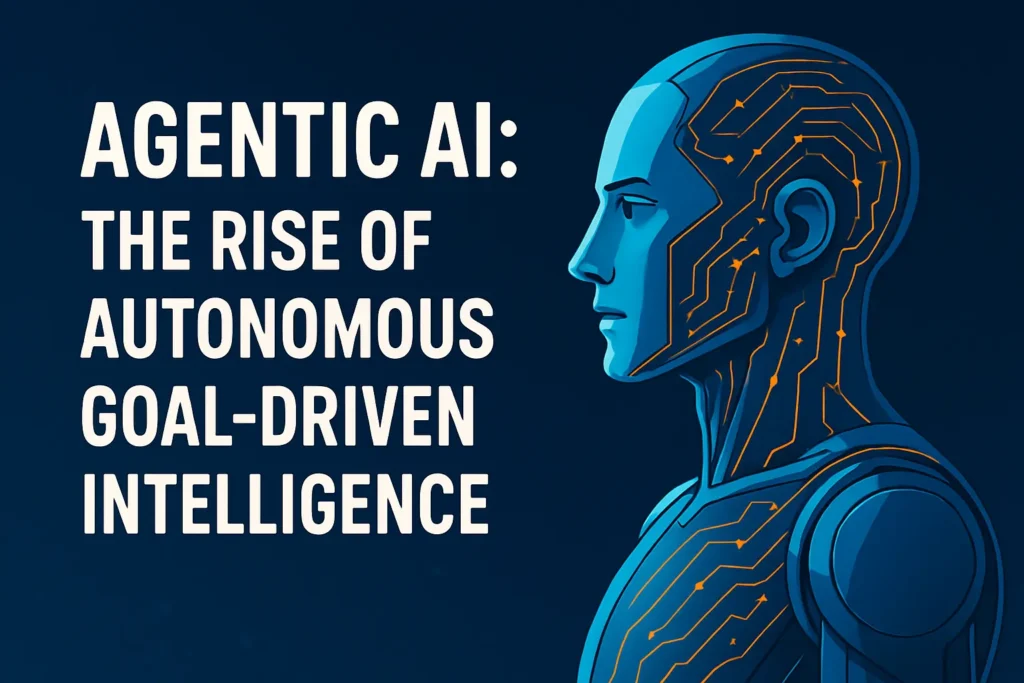Agentic AI refers to autonomous artificial intelligence systems that plan, reason, and act independently to accomplish specific goals or complex tasks with minimal or no human intervention. These systems differ significantly from traditional or generative AI, which typically require step-by-step human prompts to produce outputs.
What is Agentic AI?
Definition in Simple Terms
Agentic AI refers to artificial intelligence systems that can act independently to achieve defined goals. Unlike typical AI models that wait for prompts, Agentic AI actively makes decisions, plans actions, and adjusts its behavior based on feedback from its environment.
Expanded Definition and Core Characteristics
- Autonomy: Operates independently in dynamic environments without constant supervision.
- Goal-Oriented Behavior: Breaks down overarching objectives into sub-goals or tasks, sequencing and adapting plans as necessary to achieve outcomes.
- Decision-Making and Reasoning: Uses contextual understanding and planning to evaluate multiple actions and choose the optimal one.
- Adaptability: Adjusts behavior in real time based on new data or changing circumstances.
- Memory and Learning: Retains past experiences, improving future decisions through reinforcement learning and memory recall.
- Proactive Initiative: Takes initiative to complete ongoing workflows and pursue goals without waiting for prompts.
Core Components of Agentic AI
Goal-Directed Behavior
Agentic AI starts with a goal and works backward to create a plan. It then takes steps to achieve that goal without further guidance.
Planning and Reasoning
These systems break down complex tasks into smaller steps and execute them in a logical order.
Perception and Interaction
Agentic AI gathers data from its digital or physical environment, adapting actions as needed.
Feedback Loops and Adaptation
Agents continuously learn from their results and modify future actions for better performance.
Understanding the Three AI Types: Generative AI, Agentic AI, and AGI
Generative AI
- Produces content like text, images, or audio based on input prompts.
- Works within a limited scope and does not act unless prompted.
- Examples: ChatGPT, Midjourney, Bard, DALL·E.
Agentic AI
- Falls between Generative AI and AGI.
- Not as smart or flexible as AGI, but more capable and autonomous than Generative AI.
- Performs tasks without needing step-by-step commands.
- Examples: AutoGPT, BabyAGI, Devin, self-driving agents.
AGI (Artificial General Intelligence)
- A theoretical AI model that matches or surpasses human intelligence.
- Can learn anything a human can, reason abstractly, and transfer knowledge between tasks.
- AGI does not yet exist but remains the long-term goal of AI research.
Comparison TableComparison Table: Generative AI vs Agentic AI vs AGI
| Feature / Type | Generative AI | Agentic AI | AGI (Artificial General Intelligence) |
| Definition | Produces content like text, images, or audio when prompted. | Acts autonomously based on goals, not just prompts. | A future AI that thinks and learns like a human. |
| Scope of Intelligence | Narrow (specific tasks only) | Broader (goal-oriented tasks) | Broadest (human-like general intelligence) |
| Autonomy | No autonomy; needs human input | Semi-autonomous; acts on goals | Fully autonomous decision-making |
| Learning Capability | Pre-trained; cannot learn new tasks independently | Can adapt to task outcomes, limited self-learning | Learns like humans across all domains |
| Examples | ChatGPT, Bard, Midjourney, DALL·E | AutoGPT, BabyAGI, Devin, self-driving agents | Currently hypothetical (future tech) |
| Task Handling | Step-by-step instructions | Multi-step, hands-off execution | Understands context, plans, learns, reasons |
| Flexibility | Low (prompt-bound) | Moderate (can change behavior per goal) | High (general purpose) |
| User Interaction | Requires constant user prompts | Minimal interaction once goal is set | Potentially functions independently |
| Existence | Actively used today | Emerging (in development/testing) | Not yet achieved (theoretical) |
| Use Cases | Content creation, image generation, summarization | Research automation, coding, data extraction, agents | General intelligence, full decision-making |
How Agentic AI Works
Autonomous Decision-Making
Agentic AI uses internal logic and prior experience to make decisions.
Environment Sensing and Acting
It adapts actions based on external feedback, data, or sensor input.
Learning from Outcomes
Uses trial and error or reinforcement learning to refine performance over time.
Real-World Applications and Examples
- AutoGPT: Executes tasks like web searches, code generation, and data analysis independently.
- BabyAGI: Reprioritizes tasks dynamically based on outcomes.
- Devin: An autonomous AI software engineer.
- Self-driving systems: Make real-time decisions for navigation and safety.
- Enterprise automation: Executes adaptive workflows that standard automation cannot handle.
Technical Foundations and AI Models Involved
- Large Language Models (LLMs): Enable contextual reasoning and understanding.
- Planning AI: Helps with sequencing actions and building task trees.
- Reinforcement Learning (RL): Provides self-improvement through experience.
- Memory Systems: Store knowledge and recall past interactions.
- Tool Integration: Agentic AI uses APIs, plugins, or other tools to operate across systems.
Benefits and Opportunities
- Enhanced Autonomy: Reduces the need for constant supervision.
- Improved Efficiency: Handles multi-step workflows end-to-end.
- Cross-Industry Applications: Useful in finance, education, healthcare, and logistics.
- Continuous Learning: Agents evolve through feedback and improve their strategies.
Risks and Ethical Considerations
- Loss of Control: Poor goal setting may lead to unwanted outcomes.
- Security Risks: Autonomous systems can access sensitive data.
- Bias and Misuse: Agents can reflect training bias or be used unethically.
- Transparency: Hard to track or explain decision logic.
Agentic AI and the Future of AGI
Is Agentic AI a Step Toward AGI?
Yes. Agentic AI showcases early forms of reasoning and autonomy, serving as a milestone toward human-level intelligence.
Limitations
It lacks deep understanding, emotions, or real generalization across tasks.
Research Directions
Active areas include improving memory, ensuring goal alignment, and enhancing reasoning.
Final Thoughts
Current State
Agentic AI is already active in tools like Devin, AutoGPT, and experimental robotics.
What’s Next?
Smarter and more autonomous systems, along with ethical standards and safety tools.
Should You Be Concerned or Excited?
Both. With responsible development, Agentic AI can unlock incredible value while minimizing risks.
Further Reading
- OpenAI: Introducing ChatGPT Agent (blog)
- DeepMind: SIMA — Scalable Instructable Multiworld Agent (research highlight)
- GitHub: AutoGPT source project
- Cognition AI: Devin – AI software engineer
- LangChain agent framework overview
Stay Ahead with Future Tech
Want more simplified tech insights like this?
Explore the blog section on Guidlix.com for smart updates, trending topics, and in-depth guides designed for curious minds.
From AI trends to real-world tech breakdowns, we make it easy to understand the digital world—without the fluff.



